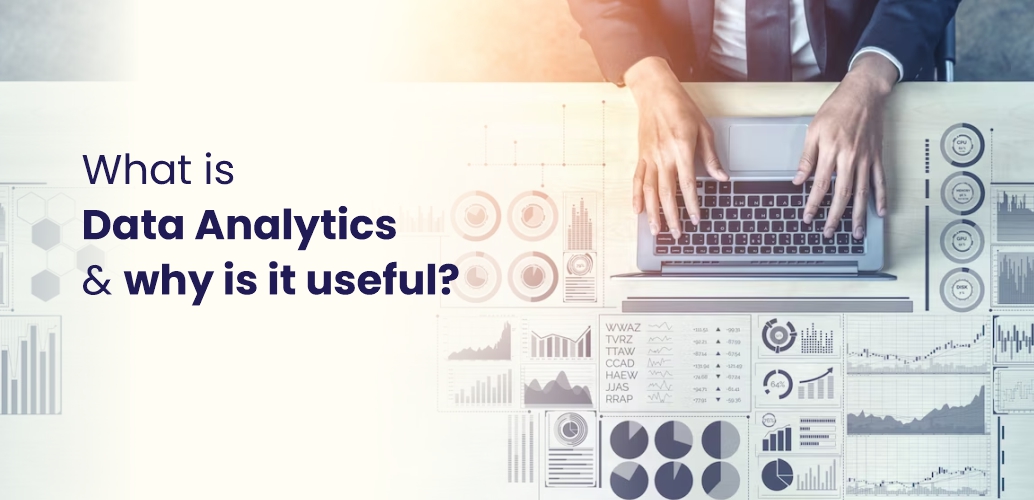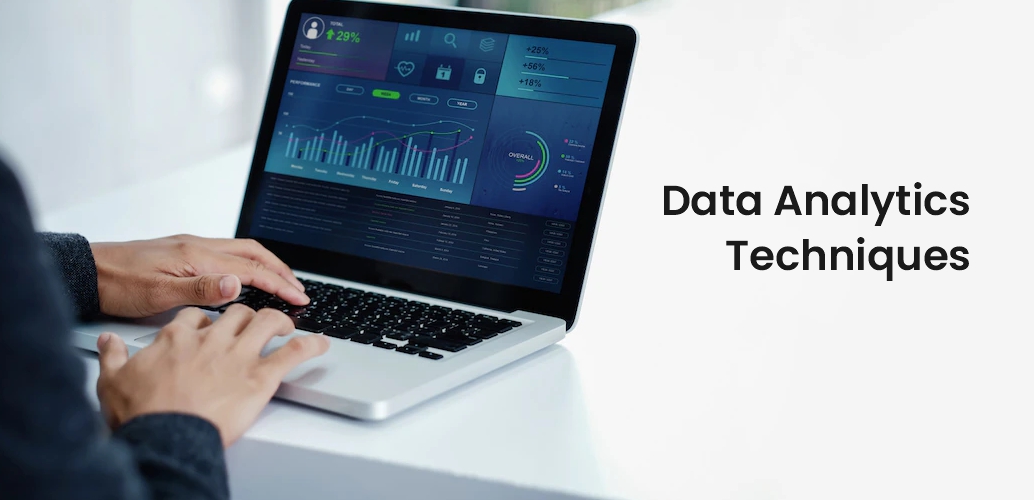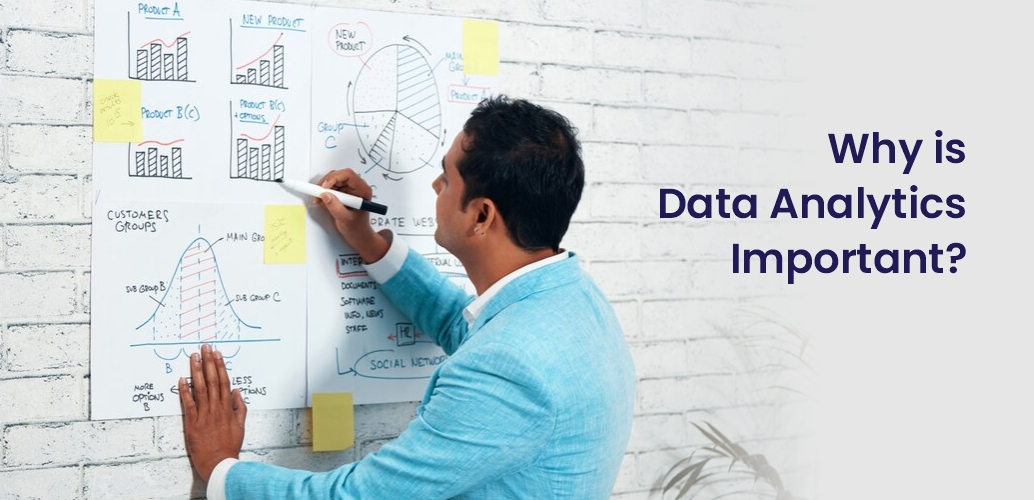Blog > What is Data Analytics and why is it useful?
What is Data Analytics and why is it useful?
January 30th, 2023

Table of Contents
Starting with the most important question - what is Data Analytics?
Did we lose you in jargon?
Before we go deeper into the Data Analysis definition, let us try understanding what is data and information. In a nutshell, data is raw, disorganised facts and figures. Information is data that has been processed, organised and presented in the right context. Data Analytics looks at the raw data, converts it into meaningful information so that organisations can make informed decisions.
Let us understand this process with an example.
Here’s how you’d use Data Analysis.
Step 1) Define the problem and objectives: Your first step would be to figure out what the problem you are trying to solve is. That way, you will be able to clearly define what is the key objective of data analysis. In our case, understand what your customers are into and how you can drive the sales of special edition Marvel-ous Threads T-shirts.
Step 2) Data collection and preparation: Next, you’ll collect all the data from various sources, such as surveys, store databases, spreadsheets, etc. You will clean, format and prepare the data so that it is analysis-ready. For Marvel-ous Threads, you may want to fill in missing data like age groups, gender on the basis of name, or remove irrelevant and duplicate data, like buying 3 shirts of the same type or even socks.
Step 3) Data Visualization: A picture is worth a thousand rows and columns. So your next step is to represent the purchase behaviour of your customer in easy-to-understand forms like histograms, scatter plots, or box plots. That way, you can correlate the data and answer queries like “Which season do most shirts get sold in the district of Asgard-borough?”
Step 4) Data Modelling: Next, you will use a Machine Learning model to analyse the data and get insights. For example, you can use linear regression to understand how the price affects the sales of the shirts. And then you can arrive at an optimum price that will enable you to meet the required sales and still remain profitable.
Step 5) Communicate the results: Following the above data analysis and interpretation, it is very important for you to communicate the results to the relevant teams and decision makers through reports or dashboards.
Step 6) Plan of action: Once all the stakeholders have reviewed the results of the data analysis, it is important to come up with a plan of action and implement it. For example, you may end up with special offers for the Marvel-ous Threads T-shirts during the movie launch season.
Now that you understand what is data analytics, let us look at some of the techniques to perform data analysis.
Having seen how Marvel-ous Threads would use data analysis, you should be able to answer the question - why is data driven analytics of interest to companies? If not, let’s clarify it further:
Many mistakenly confuse the two; but while the two fields are closely related, they are and must be treated separately.
A data analyst’s primary focus is to clean, transform and present the data using which insights can be made. A data scientist takes this data a step further and also builds Machine Learning models to extract meaningful insights from the data. So, in the case of Marvel-ous Threads, a Data Analyst will collect the details of the sales of new T-shirts in every area for every type of customer in the last 3 months, remove the unnecessary data and present the details in contrast with the marketing spends. A Data Scientist will build predictive models to understand where the marketing efforts are high-paying to maximise the sales.
We hope this definitive guide on Data Analytics has answered all your queries on kickstarting a career in this exciting field. The best place to start is our Data Science & Analytics course, which is designed specially for beginners.
Interested in knowing more? Ask your questions in the comments below.
- Understanding Data Analytics Basics
- Data Analytics Techniques
- Data Analytics Tools
- Why is Data Analytics Important?
- What are the 4 Types of Data Analytics?
- Data Analytics and its Future Scope in 2023
- Data Analyst vs. Data Scientist
- Conclusion
Starting with the most important question - what is Data Analytics?
Understanding Data Analytics Basics
Data Analytics empowers businesses to make informed decisions and improve their operations, and at the heart of all this lies data. Data Analytics is a branch of Data Science and it involves collecting, examining, cleaning, transforming and modelling data. Using this, organisations are able to discover useful information, draw conclusions and make operational decisions that will meet their organisational objectives.Did we lose you in jargon?
Before we go deeper into the Data Analysis definition, let us try understanding what is data and information. In a nutshell, data is raw, disorganised facts and figures. Information is data that has been processed, organised and presented in the right context. Data Analytics looks at the raw data, converts it into meaningful information so that organisations can make informed decisions.
Let us understand this process with an example.
Data Analysis Steps with Examples
| Imagine if you owned a clothes store called Marvel-ous Threads that sold MCU merchandise like figurines, T-shirts, keychains and more. You want to launch a new special edition T-shirt before the upcoming movie gets released. |
Here’s how you’d use Data Analysis.
Step 1) Define the problem and objectives: Your first step would be to figure out what the problem you are trying to solve is. That way, you will be able to clearly define what is the key objective of data analysis. In our case, understand what your customers are into and how you can drive the sales of special edition Marvel-ous Threads T-shirts.
Step 2) Data collection and preparation: Next, you’ll collect all the data from various sources, such as surveys, store databases, spreadsheets, etc. You will clean, format and prepare the data so that it is analysis-ready. For Marvel-ous Threads, you may want to fill in missing data like age groups, gender on the basis of name, or remove irrelevant and duplicate data, like buying 3 shirts of the same type or even socks.
Step 3) Data Visualization: A picture is worth a thousand rows and columns. So your next step is to represent the purchase behaviour of your customer in easy-to-understand forms like histograms, scatter plots, or box plots. That way, you can correlate the data and answer queries like “Which season do most shirts get sold in the district of Asgard-borough?”
Step 4) Data Modelling: Next, you will use a Machine Learning model to analyse the data and get insights. For example, you can use linear regression to understand how the price affects the sales of the shirts. And then you can arrive at an optimum price that will enable you to meet the required sales and still remain profitable.
Step 5) Communicate the results: Following the above data analysis and interpretation, it is very important for you to communicate the results to the relevant teams and decision makers through reports or dashboards.
Step 6) Plan of action: Once all the stakeholders have reviewed the results of the data analysis, it is important to come up with a plan of action and implement it. For example, you may end up with special offers for the Marvel-ous Threads T-shirts during the movie launch season.
Data Analytics Techniques

Now that you understand what is data analytics, let us look at some of the techniques to perform data analysis.
Regression Analysis
Regression Analysis is a statistical method used to determine the relationship between a dependent variable on two or more independent variables. Taking our Marvel-ous Threads example, the number of sales depends on the price of the T-shirt. It may also depend on the age group of the customer. In this case, the number of sales is a dependent variable; the price and age group are independent variables. With Regression Analysis, we can map a relationship between these variables.Factor Analysis
With Factor analysis, you can identify the variables that contribute to being a factor in a relationship. In our Marvel-ous Threads example, the customer data captured could be name, age, gender, location, phone number, email address, etc. Now some of the factors that have nothing to do with the amount of sales would be name, phone number and email address. Factor analysis helps eliminate these variables from the data analysis, and also determine how exactly age, gender and location are related to the sales of the T-shirts.Cohort Analysis
Cohort Analysis is a way of grouping different entities together into a cohort based on a common characteristic. For example, all women from ages 25 to 33 living in Asgard-borough could form one cohort and all women from ages 21 to 24 living near Antman-shire could form another cohort. Now Marvel-ous Threads needs to understand which cohort performs better during which months, etc. to make their marketing decisions.Time Series Analysis
As the name suggests, Time Series analysis involves the factor of time. For example, which are the months when Marvel-ous Threads have the most sales? Is it near a festive season or during a franchise launch? Does the T-shirt sales drop over winter and that of a jumper increases?Data Analytics Tools
All of the above techniques are implemented using data analysis tools. The most common data analysis tools include:- Excel: Excel is an easy-to-use interface for building reports, charts and pivot tables, along with complex functions and formulae.
- Python & Python libraries: The large number of libraries and frameworks make Python practically an indispensable skillset for data analysis functions like linear regression, data transformation, etc.
- Tableau: Tableau is a data visualisation dashboard that is used to make charts, treemaps, histograms and other elements for effective data storytelling.
- MySQL: MySQL is an open source relational database management system that is used for storing, extracting and manipulating data. It is usually used in combination with a programming language like Python.
Why is Data Analytics Important?

Having seen how Marvel-ous Threads would use data analysis, you should be able to answer the question - why is data driven analytics of interest to companies? If not, let’s clarify it further:
- Data Analytics allows companies to identify trends and patterns, measure performance, and make predictions.
- Data analysis in research, specifically corporate research, is one of its biggest uses. Data analytics is used in:
- Market research (e.g. consumer preferences)
- Customer analytics (e.g. consumer segmentation)
- Financial analysis (e.g. revenue forecast and budgeting)
- Operational analysis (e.g. where efficiency can be improved)
- Data Analytics also helps uncover areas of improvement, detect fraud, and understand risks and investments to make informed decisions.
What are the 4 Types of Data Analytics?
When we explained what is Data Analytics, we spoke of deriving insights from data. Based on the data you’re analysing and the type of insights you want to derive, Data Analytics can be divided into 4 categories:-
Descriptive Analytics
To put it simply, Descriptive Analytics describes a story. It views historical data and presents the same in a summarised form to explain what happened in the past. For example, the sales history of Marvel-ous Threads T-shirts in a particular region. -
Diagnostics Analytics
As the name suggests, Diagnostics Analytics diagnoses historical data to come up with a root cause of a problem/trend. For example, why are the sales of Marvel-ous Threads T-shirts higher for men than women? -
Predictive Analytics
Predictive Analytics is used to make predictions on future trends and events based on the analysis of past data. For example, how many Quantamania T-shirts can be sold by Marvel-ous Threads based on the sales of Loki T-shirts? -
Prescriptive Analytics
Prescriptive Analytics takes all other types of analytics a step further and makes recommendations to meet certain objectives. For example, Prescriptive Analytics for Marvel-ous Threads will recommend which areas/customer segments need more marketing to get good sales, and which areas are not worth investing in.
Data Analytics and its Future Scope in 2023
As the world is getting increasingly reliant on data and tech, the scope of Data Analytics is correspondingly expanding too. Data Analytics will definitely impact all important industries like:- Healthcare - From Electronic Health Records (EHR) to Clinical Decision Support, Data Analytics will improve patient experience and also improve operational efficiency for hospitals and healthcare providers.
- Finance - Data Analytics will strengthen existing financial systems by analysing spending and purchasing patterns. This will be used in fraud detection, portfolio management, predicting stock prices, etc.
- Retail - As already explained with Marvel-ous Threads, Data Analytics will find increased usage in customer segmentation, purchase behaviour analysis, sales forecasting and more.
- Telecommunication - As the number of internet users keeps growing, Data Analytics will play a big role in network optimisation, fraud detection, usage pattern analysis and prediction, etc.
- Manufacturing - There are many processes which can be optimised with Data Analytics in the manufacturing side. These include - energy efficiency, supply chain, quality control, inventory management, etc.
- Data Analysts
- Data Scientists
- Data Engineers
- Machine Learning Engineers
- Data Visualisation Designers
Data Analyst vs. Data Scientist
As we look into the career opportunities in the field of Data Analytics, there’s an important point we need to address. And that’s the difference between Data Analysts and Data Scientists.Many mistakenly confuse the two; but while the two fields are closely related, they are and must be treated separately.
A data analyst’s primary focus is to clean, transform and present the data using which insights can be made. A data scientist takes this data a step further and also builds Machine Learning models to extract meaningful insights from the data. So, in the case of Marvel-ous Threads, a Data Analyst will collect the details of the sales of new T-shirts in every area for every type of customer in the last 3 months, remove the unnecessary data and present the details in contrast with the marketing spends. A Data Scientist will build predictive models to understand where the marketing efforts are high-paying to maximise the sales.
Conclusion

We hope this definitive guide on Data Analytics has answered all your queries on kickstarting a career in this exciting field. The best place to start is our Data Science & Analytics course, which is designed specially for beginners.
Interested in knowing more? Ask your questions in the comments below.






Add a Comment